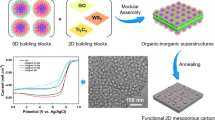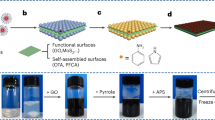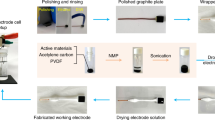Abstract
The large pores of functional mesoporous carbonaceous nanomaterials have broad accessibility, making them efficient substrates for the mass transport of chemicals in biomedical applications, gas separation, catalysis, sensing, and energy storage and conversion. Recently, the assembly of monomicelles has been used to control the nanostructure and mesoporosity of carbonaceous nanomaterials, where the structure-oriented unit is a single micelle made up of block copolymers/surfactants and of precursor species (via hydrogen bonds, Coulombic and/or other noncovalent interactions). Each monomicelle then represents a template for a single mesopore, and multiple monomicelles can be stacked like LEGO blocks. After polymerization of the precursor species (in this case dopamine), carbonization results in the carbonaceous nanomaterial. The micellar size, structure and shape can be easily tuned by altering the synthetic conditions, providing a high degree of control over the structure of the final product, which can therefore be shaped into original nanostructures otherwise difficult to synthesize using conventional templating methods. Here we provide a detailed procedure for the preparation of the monomicelles, the monomicellar assembly into mesostructured polymeric samples and the conversion of polymeric samples to carbonaceous frameworks. We describe the functional characterization of two mesoporous carbonaceous nanomaterials that demonstrate excellent sodium-ion storage performance and oxygen reduction reactivity, respectively. The monomicellar assembly process for the synthesis of the ordered mesoporous polymers requires ~5 h; the synthesis, including subsequent centrifugation, freeze drying and carbonization, requires 2 d, whereas the entire procedure, including the characterization of the nanomaterials, requires ~4 d.
This is a preview of subscription content, access via your institution
Access options
Access Nature and 54 other Nature Portfolio journals
Get Nature+, our best-value online-access subscription
$29.99 / 30 days
cancel any time
Subscribe to this journal
Receive 12 print issues and online access
$259.00 per year
only $21.58 per issue
Buy this article
- Purchase on Springer Link
- Instant access to full article PDF
Prices may be subject to local taxes which are calculated during checkout










Similar content being viewed by others
Data availability
All data supporting the findings of this study are included in the article and its Supplementary Information.
References
Li, W., Liu, J. & Zhao, D. Mesoporous materials for energy conversion and storage devices. Nat. Rev. Mater. 1, 16023 (2016).
Duan, L. et al. Interfacial assembly and applications of functional mesoporous materials. Chem. Rev. 121, 14349–14429 (2021).
Zhao, D. et al. Triblock copolymer syntheses of mesoporous silica with periodic 50 to 300 angstrom pores. Science 279, 548–552 (1998).
Ryoo, R. et al. Rare-earth-platinum alloy nanoparticles in mesoporous zeolite for catalysis. Nature 585, 221–224 (2020).
Zu, L. et al. Self-assembly of Ir-based nanosheets with ordered interlayer space for enhanced electrocatalytic water oxidation. J. Am. Chem. Soc. 144, 2208–2217 (2022).
Guan, B. Y., Yu, L. & Lou, X. W. Formation of asymmetric bowl-like mesoporous particles via emulsion-induced interface anisotropic assembly. J. Am. Chem. Soc. 138, 11306–11311 (2016).
Hung, C.-T. et al. Gradient hierarchically porous structure for rapid capillary-assisted catalysis. J. Am. Chem. Soc. 144, 6091–6099 (2022).
Wang, R. et al. Janus mesoporous sensor devices for simultaneous multivariable gases detection. Matter 1, 1274–1284 (2019).
Ariga, K. et al. A layered mesoporous carbon sensor based on nanopore-filling cooperative adsorption in the liquid phase. Angew. Chem. Int. Ed. 47, 7254–7257 (2008).
Ren, Y. et al. Synthesis of orthogonally assembled 3D cross-stacked metal oxide semiconducting nanowires. Nat. Mater. 19, 203–211 (2020).
Yuan, Y.-F. et al. Wiggling mesopores kinetically amplify the adsorptive separation of propylene/propane. Angew. Chem. Int. Ed. 60, 19063–19067 (2021).
Zhao, T. et al. Surface-kinetics mediated mesoporous multipods for enhanced bacterial adhesion and inhibition. Nat. Commun. 10, 4387 (2019).
Oh, J. Y. et al. Cloaking nanoparticles with protein corona shield for targeted drug delivery. Nat. Commun. 9, 4548 (2018).
Kankala, R. K. et al. Nanoarchitectured structure and surface biofunctionality of mesoporous silica nanoparticles. Adv. Mater. 32, 1907035 (2020).
Zhi, J., Zhou, M., Zhang, Z., Reiser, O. & Huang, F. Interstitial boron-doped mesoporous semiconductor oxides for ultratransparent energy storage. Nat. Commun. 12, 445 (2021).
Yan, Y. et al. Mesoporous nanoarchitectures for electrochemical energy conversion and storage. Adv. Mater. 32, 2004654 (2020).
Kresge, C. T., Leonowicz, M. E., Roth, W. J., Vartuli, J. C. & Beck, J. S. Ordered mesoporous molecular sieves synthesized by a liquid-crystal template mechanism. Nature 359, 710–712 (1992).
Guan, B. Y., Zhang, S. L. & Lou, X. W. Realization of walnut-shaped particles with macro-/mesoporous open channels through pore architecture manipulation and their use in electrocatalytic oxygen reduction. Angew. Chem. Int. Ed. 130, 6284–6288 (2018).
Fang, Y. et al. Interface tension-induced synthesis of monodispersed mesoporous carbon hemispheres. J. Am. Chem. Soc. 137, 2808–2811 (2015).
Liu, Y. et al. Radially oriented mesoporous TiO2 microspheres with single-crystal-like anatase walls for high-efficiency optoelectronic devices. Sci. Adv. 1, e1500166 (2015).
Li, X. et al. Anisotropic growth-induced synthesis of dual-compartment Janus mesoporous silica nanoparticles for bimodal triggered drugs delivery. J. Am. Chem. Soc. 136, 15086–15092 (2014).
Jiang, B. et al. Mesoporous metallic iridium nanosheets. J. Am. Chem. Soc. 140, 12434–12441 (2018).
Wei, J. et al. New insight into the synthesis of large-pore ordered mesoporous materials. J. Am. Chem. Soc. 139, 1706–1713 (2017).
Kim, S., Hwang, J., Lee, J. & Lee, J. Polymer blend directed anisotropic self-assembly toward mesoporous inorganic bowls and nanosheets. Sci. Adv. 6, eabb3814 (2020).
Liu, J. et al. A facile soft-template synthesis of mesoporous polymeric and carbonaceous nanospheres. Nat. Commun. 4, 2798 (2013).
Liu, Y. et al. Dopamine-melanin colloidal nanospheres: an efficient near-infrared photothermal therapeutic agent for in vivo cancer therapy. Adv. Mater. 25, 1353–1359 (2013).
Yang, Z.-C. et al. Hollow carbon nanoparticles of tunable size and wall thickness by hydrothermal treatment of α-cyclodextrin templated by F127 block copolymers. Chem. Mater. 25, 704–710 (2013).
Hou, H., Banks, C. E., Jing, M., Zhang, Y. & Ji, X. Carbon quantum dots and their derivative 3D porous carbon frameworks for sodium-ion batteries with ultralong cycle life. Adv. Mater. 27, 7861–7866 (2015).
Xu, F. et al. Facile synthesis of ultrahigh-surface-area hollow carbon nanospheres for enhanced adsorption and energy storage. Nat. Commun. 6, 7221 (2015).
Kim, M. et al. Tailored nanoarchitecturing of microporous ZIF-8 to hierarchically porous double-shell carbons and their intrinsic electrochemical property. ACS Appl. Mater. Interfaces 12, 34065–34073 (2020).
Kim, M. et al. KOH-activated hollow ZIF-8 derived porous carbon: nanoarchitectured control for upgraded capacitive deionization and supercapacitor. ACS Appl. Mater. Interfaces 13, 52034–52043 (2021).
Kim, M. et al. Efficient lithium-ion storage using a heterostructured porous carbon framework and its in situ transmission electron microscopy study. Chem. Commun. 58, 863–866 (2022).
Kong, B. et al. Incorporation of well-dispersed sub-5-nm graphitic pencil nanodots into ordered mesoporous frameworks. Nat. Chem. 8, 171–178 (2016).
Che, S. et al. Synthesis and characterization of chiral mesoporous silica. Nature 429, 281–284 (2004).
Yang, P., Zhao, D., Margolese, D. I., Chmelka, B. F. & Stucky, G. D. Generalized syntheses of large-pore mesoporous metal oxides with semicrystalline frameworks. Nature 396, 152–155 (1998).
Ryoo, R., Joo, S. H. & Jun, S. Synthesis of highly ordered carbon molecular sieves via template-mediated structural transformation. J. Phys. Chem. B 103, 7743–7746 (1999).
Lee, J., Yoon, S., Oh, S. M., Shin, C.-H. & Hyeon, T. Development of a new mesoporous carbon using an HMS aluminosilicate template. Adv. Mater. 12, 359–362 (2000).
Wang, G. et al. Controlled synthesis of N-doped carbon nanospheres with tailored mesopores through self-assembly of colloidal silica. Angew. Chem. Int. Ed. 127, 15406–15411 (2015).
Kim, K. et al. Lanthanum-catalysed synthesis of microporous 3D graphene-like carbons in a zeolite template. Nature 535, 131–135 (2016).
Meng, Y. et al. Ordered mesoporous polymers and homologous carbon frameworks: amphiphilic surfactant templating and direct transformation. Angew. Chem. Int. Ed. 44, 7053–7059 (2005).
Zhang, F. et al. A facile aqueous route to synthesize highly ordered mesoporous polymers and carbon frameworks with Ia3̄d bicontinuous cubic structure. J. Am. Chem. Soc. 127, 13508–13509 (2005).
Giese, M., Blusch, L. K., Khan, M. K. & MacLachlan, M. J. Functional materials from cellulose-derived liquid-crystal templates. Angew. Chem. Int. Ed. 54, 2888–2910 (2015).
Antonelli, D. M., Nakahira, A. & Ying, J. Y. Ligand-assisted liquid crystal templating in mesoporous niobium oxide molecular sieves. Inorg. Chem. 35, 3126–3136 (1996).
Zhao, D., Huo, Q., Feng, J., Chmelka, B. F. & Stucky, G. D. Nonionic triblock and star diblock copolymer and oligomeric surfactant syntheses of highly ordered, hydrothermally stable, mesoporous silica structures. J. Am. Chem. Soc. 120, 6024–6036 (1998).
Zhao, Z. et al. General synthesis of ultrafine monodispersed hybrid nanoparticles from highly stable monomicelles. Adv. Mater. 33, 2100820 (2021).
Peng, L. et al. Programmable synthesis of radially gradient-structured mesoporous carbon nanospheres with tunable core-shell architectures. Chem 7, 1020–1032 (2021).
Peng, L. et al. Spiral self-assembly of lamellar micelles into multi-shelled hollow nanospheres with unique chiral architecture. Sci. Adv. 7, eabi7403 (2021).
Wang, R. et al. Precisely controlled vertical alignment in mesostructured carbon thin films for efficient electrochemical sensing. ACS Nano 15, 7713–7721 (2021).
Peng, L. et al. Versatile nanoemulsion assembly approach to synthesize functional mesoporous carbon nanospheres with tunable pore sizes and architectures. J. Am. Chem. Soc. 141, 7073–7080 (2019).
Zhao, T. et al. Spatial isolation of carbon and silica in a single Janus mesoporous nanoparticle with tunable amphiphilicity. J. Am. Chem. Soc. 140, 10009–10015 (2018).
Xie, L. et al. Sequential superassembly of nanofiber arrays to carbonaceous ordered mesoporous nanowires and their heterostructure membranes for osmotic energy conversion. J. Am. Chem. Soc. 143, 6922–6932 (2021).
Lee, Y. J. et al. Lens-shaped carbon particles with perpendicularly-oriented channels for high-performance proton exchange membrane fuel cells. ACS Nano 16, 2988–2996 (2022).
Peng, H. et al. Pore and heteroatom engineered carbon foams for supercapacitors. Adv. Energy Mater. 9, 1803665 (2019).
Pan, P. et al. Interface coassembly and polymerization on magnetic colloids: toward core-shell functional mesoporous polymer microspheres and their carbon derivatives. Adv. Sci. 7, 2000443 (2020).
Lin, K. et al. Hollow mesoporous polydopamine nanospheres: synthesis, biocompatibility and drug delivery. Nanotechnology 32, 285602 (2021).
Wen, B. et al. Synthesis of core-shell Co@S-doped carbon@ mesoporous N-doped carbon nanosheets with a hierarchically porous structure for strong electromagnetic wave absorption. J. Mater. Chem. A 9, 3567–3575 (2021).
Peng, L. et al. Anisotropic self-assembly of asymmetric mesoporous hemispheres with tunable pore structures at liquid-liquid interfaces. J. Am. Chem. Soc. 144, 15754–15763 (2022).
Guo, D. et al. Monodisperse ultrahigh nitrogen-containing mesoporous carbon nanospheres from melamine-formaldehyde resin. Small Methods 5, 2001137 (2021).
Zhu, X. et al. Synthesis of carbon nanotubes@mesoporous carbon core-shell structured electrocatalysts via a molecule-mediated interfacial co-assembly strategy. J. Mater. Chem. A 7, 8975–8983 (2019).
Lan, K. et al. Two-dimensional mesoporous heterostructure delivering superior pseudocapacitive sodium storage via bottom-up monomicelle assembly. J. Am. Chem. Soc. 141, 16755–16762 (2019).
Lin, G., Zheng, J. & Xu, R. Template-free synthesis of uniform CdS hollow nanospheres and their photocatalytic activities. J. Phys. Chem. C 112, 7363–7370 (2008).
Zhang, L. et al. Magnetic-mesoporous Janus nanoparticles. Chem. Commun. 47, 1225–1227 (2011).
Lan, K. et al. Uniform ordered two-dimensional mesoporous TiO2 nanosheets from hydrothermal-induced solvent-confined monomicelle assembly. J. Am. Chem. Soc. 140, 4135–4143 (2018).
Acknowledgements
This work was supported by the National Key R&D Program of China (2018YFA0209401, 2018YFE0201701 and 2017YFA0207303), National Natural Science Foundation of China (grant nos. 22105041, 21733003 and U21A20329 21975050), Program of Shanghai Academic Research Leader (21XD1420800) and Shanghai Pilot Program for Basic Research-Fudan University 21TQ1400100 (21TQ008) and Science and Technology Commission of Shanghai Municipality (19JC1410700).
Author information
Authors and Affiliations
Contributions
L.P., W.L. and D.Z. developed the protocol and co-drafted the manuscript. H.P. contributed to the discussion and manuscript modification.
Corresponding authors
Ethics declarations
Competing interests
The authors declare no competing interests.
Peer review
Peer review information
Nature Protocols thanks Yusuke Yamauchi and the other, anonymous, reviewer(s) for their contribution to the peer review of this work.
Additional information
Publisher’s note Springer Nature remains neutral with regard to jurisdictional claims in published maps and institutional affiliations.
Related links
Key reference using this protocol
Zhao, T. et al. J. Am. Chem. Soc. 140, 10009–10015 (2018): https://doi.org/10.1021/jacs.8b06127
Zhu, X. et al. J. Mater. Chem. A 7, 8975–8983 (2019): https://doi.org/10.1039/C9TA01478K
Peng, L. et al. J. Am. Chem. Soc. 141, 7073–7080 (2019): https://doi.org/10.1021/jacs.9b02091
Peng, L. et al. Sci. Adv. 7, eabi7403 (2021): https://www.science.org/doi/10.1126/sciadv.abi7403
Peng, L. et al. Chem 7, 1020–1032 (2021): https://doi.org/10.1016/j.chempr.2021.01.001
Supplementary information
Supplementary Information
Supplementary Figs. 1–8.
Rights and permissions
Springer Nature or its licensor (e.g. a society or other partner) holds exclusive rights to this article under a publishing agreement with the author(s) or other rightsholder(s); author self-archiving of the accepted manuscript version of this article is solely governed by the terms of such publishing agreement and applicable law.
About this article
Cite this article
Peng, L., Peng, H., Li, W. et al. Monomicellar assembly to synthesize structured and functional mesoporous carbonaceous nanomaterials. Nat Protoc 18, 1155–1178 (2023). https://doi.org/10.1038/s41596-022-00784-6
Received:
Accepted:
Published:
Issue Date:
DOI: https://doi.org/10.1038/s41596-022-00784-6
This article is cited by
-
One-dimensionally oriented self-assembly of ordered mesoporous nanofibers featuring tailorable mesophases via kinetic control
Nature Communications (2023)
-
Solvent-pair surfactants enabled assembly of clusters and copolymers towards programmed mesoporous metal oxides
Nature Communications (2023)
Comments
By submitting a comment you agree to abide by our Terms and Community Guidelines. If you find something abusive or that does not comply with our terms or guidelines please flag it as inappropriate.



